
Kos / Κως
Visiting Kos
I'm arriving at Kos or Κως, the home of Hippocrates. He was born on an island that already had a long tradition as a healing center. Along with whatever was happening in China, the Asclepeion of Kos was the ancient world's premier medical training school and a working hospital.

Portion of Tactical Pilotage Chart G-3B from the Perry Castañeda Library Map Collection at the University of Texas.
Kos is one of the Dodecanese islands, close to the Asian mainland. The eastern end of Kos lies between the western tips of two Turkish peninsulas. The main town, also named Kos, is at the west end of the narrow island, 40 kilometers long by 8 kilometers wide. It's a shorter distance from Kos town to Bodrum, Turkey, than it is to the west end of the same island.
On small islands like Ios, Mykonos, or Patmos, the main town is called Χορα or Hora, meaning "the Town".
Kos, like Thera, is in the second tier, with multiple towns and the most prominent having the same name as the island.
The largest Greek island, Crete, has many individually named towns.
Arrival at the Harbor
Kos has ferry service to Rhodes, Nisiros, Simi, Leros, and Siros. Plus, with advanced reservation and lots of paperwork, to Bodrum, Turkey.

Plus, there may be connections to and from Patmos. Many more people go to Kos, so there may be day-trip boats from Kos to Patmos in the morning, returning in the afternoon.
This was how I arrived on Kos. I had been staying on Patmos, and got a ticket on a day trip boat returning to Kos, running 1500-1800.
What a difference! Patmos was a nice place to relax. Kos was a tourism hotspot, packed with Brits on short trips, drinking and staggering and vomiting.
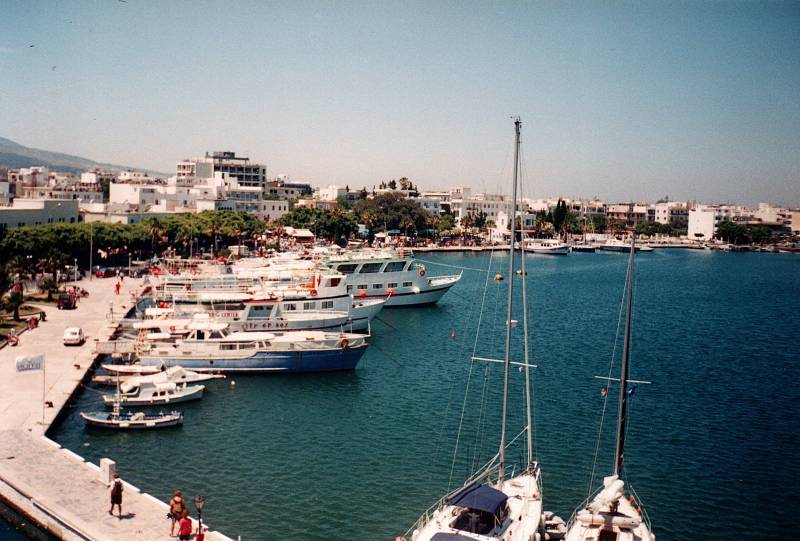
Check ferry schedules and buy tickets:
I passed the famous "Plane Tree of Hippocrates" on my way to where I stayed. Allegedly the great physician taught under this very tree. But it's a plane tree, not a bristlecone pine, so not really this tree.
Hippocrates is thought to have lived 460-377 BCE. This tree, supported by extensive scaffolding and props, is described as 200 years old by Lonely Planet, and 500 years old by the Michelin guide.
Plane trees, similar to the sycamore trees common where I live, grow quickly during the early part of their life, and can then become quite large and old. But not that old.
So this isn't the tree, but it's the same type of tree in the same place.
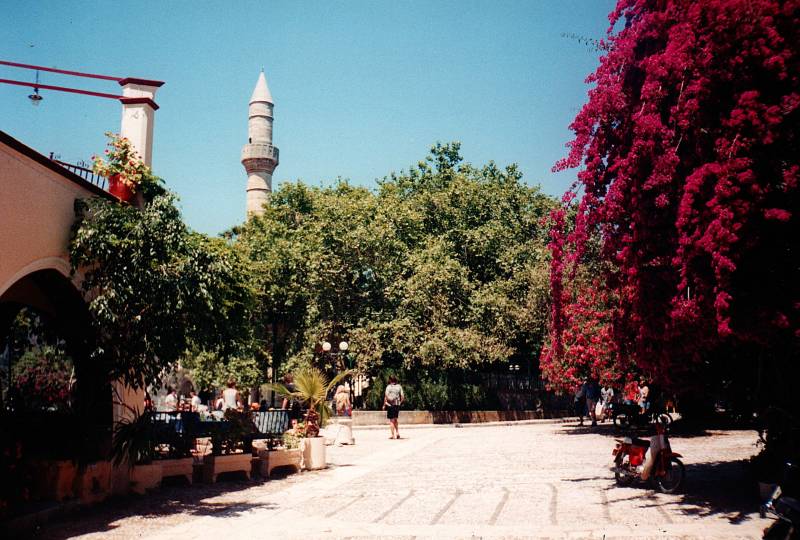
The Kos economy is based mostly on tourism now. But there is land for agriculture, where they grow grapes for the local wine, almonds, figs, olives, tomatoes, wheat, and corn.
I stayed at Pension Alexis, around the harbor and past Hippocrates' tree. It was very nice. You could hang out on the balconies in the evening. Alexis made his own retsina. He made white wine from his own grapes, then added 20 ml of pine resin to 120 liters of wine.
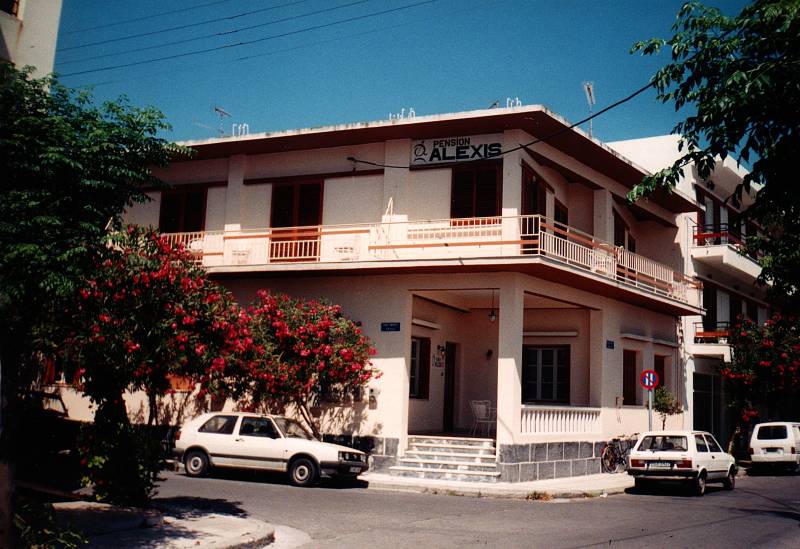
Local radio didn't offer much. Greek FM stations, especially in the islands, have power cuts and frequency drifts. Some are in stereo but with one channel either dead or a 50 Hz hum. Turkish FM stations are easily picked up in Kos, as Bodrum is visible about twenty kilometers away.
Neratzia Castle
The Knights Hospitaller, more formally the Order of Knights of the Hospital of Saint John of Jerusalem, was based in Jerusalem until 1291, on Rhodes from 1310 to 1522, Malta from 1530 to 1798, and relocated to Saint Petersburg from 1799 to 1801. They took control of Kos in 1337, during their long stay on Rhodes.
This is Neratzia Castle or Κάστρο Νεραντζιάς, their "Castle of the Sour Orange Tree".
It has two fortified curtain walls. The inner wall, the older, is rectangular with towers at its four corners. A wide ditch separates it from the outer curtain wall.
In this picture I'm on the outer wall, the ditch and inner wall are to the right.

Kos appears in early Greek mythology, in which the Battle of the Giants broke out here between the Gods of Olympus and the Giants. The god Poseidon approached the giant Polyvotis, skewered part of Cape Helona with his trident, and used that to crush the giant.
Later within the mythic timeline, Hercules was once shipwrecked on Kos.
MycenaeApproaching the boundary between prehistoric and historic, Kos came under the influence of Minoan and then Mycenaean cultures.
Homer mentioned Kos in the Iliad, describing the Trojan War of approximately 1194-1184 BCE. Homer's epics were composed about 4 centuries later. A contingent from Kos was said to have fought on the side of the Greeks.
The historicity of the Trojan War and Homer are still debated. But we know that people from Caria in southwestern Anatolia colonized Kos. Dorian Greeks then invaded in the 11th century BCE. That was when the medical tradition of Kos was established.
Sacred Island of DelosKos was ruled by tyrants appointed by Persia during the wars between Greece and Persia in the 5th century BCE. Then Kos joined the Delian League, an association of city-states that met on the sacred island of Delos at the center of the Cyclades.
Kos developed into an important trading center during the time of Alexander the Great. Kos produced silk and renowned wines. The Ptolomies established a branch of the museum of Alexandria on the island, and it was used to educate the dynasty's princes.
Kos became a free city under Roman rule in 53 CE. A provincial library was established here. The local physician Gaius Stertinius Xenophon supported the library's construction. He moved to Rome and became the personal physician of Emperors Tiberius, Claudius, and Nero. According to the Acts of the Apostles, Paul made a port call at Kos during the time it was a free city.

During the rule of the Byzantine Empire, about the only news or history out of Kos had to do with its bishops' participation in church councils. That, and the demolition of non-Christian shrines, and some destructive earthquakes, and raids by Vandals, Isaurians, Visigoths, and Saracens.
Pope Innocent III called for the Fourth Crusade in 1202, with a plan of first conquering the Ayyubid Sultante based in Egypt, the strongest Muslim state of the time, and then recapturing Jerusalem from Muslim control.
The Fourth Crusade was even more of a debacle than other Crusades. The main crusader army only got as far as Constantinople, which was Greek Orthodox and enormously wealthy. They besieged the city, captured it, and sacked it.
This led to the Byzantine Empire splitting into three states. It was eventually restored, after a fashion, in 1261, but the Fourth Crusade led to the decline of the Byzantine Empire, and then the Muslim conquests of Anatolia, Constantinople itself, and the Balkans.
Genoa and then the Nicaea fragment of the Byzantine Empire controlled Kos. Then it passed through the hands of European robber barons and Turkish corsairs.
Then in 1337 the Knights Hospitaller, based in Rhodes at the time, seized control of Kos.
The Ottoman Empire captured Kos in early 1523 and controlled it until 1911. The castle hosted the barracks of the Turkish garrison and the home of the Turkish commander of the island.
The result of this complicated history is that the architecture of Kos is an odd mixture of the sequence of regimes.
In 1687, the Parthenon in Athens was almost completely destroyed by an exploding Turkish gunpowder magazine.
In 1816 a gunpowder magazine exploded and destroyed a large section of the castle. In the late 1800s, the Ottoman census found a population of 12,965 on the island, made up of 10,459 Greeks, 2,439 Muslims, and 67 Jews.
Italy took control of Kos after the Italo-Turkish War from September 1911 to October 1912. The Italian Archaeological Department removed additions to this castle created under Ottoman control, attempting to restore it to its original form.
Kos was controlled by Italian troops during World War II until Italy's surrender in 1943. German troops took control then, executing 100 Italian officers who had refused to join the German military after Italy's surrender. The castle then hosted the German garrison and a prison holding Greek patriots.
At the end of the war, Kos became a protectorate of the UK, which transferred it to Greece in 1947.
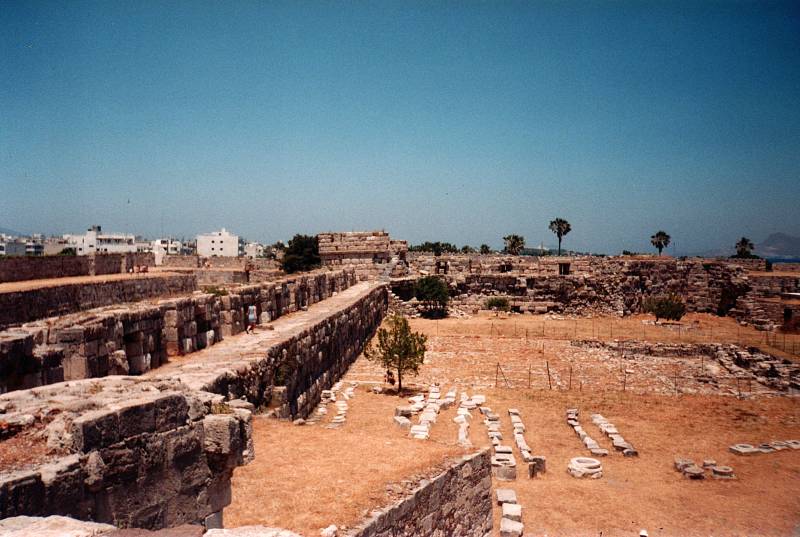
The Ancient Agora
The Agora or Αγορα, the city's market place, was one of the largest in the ancient world. It had an open rectangular yard some 300 meters long and 50 meters wide.
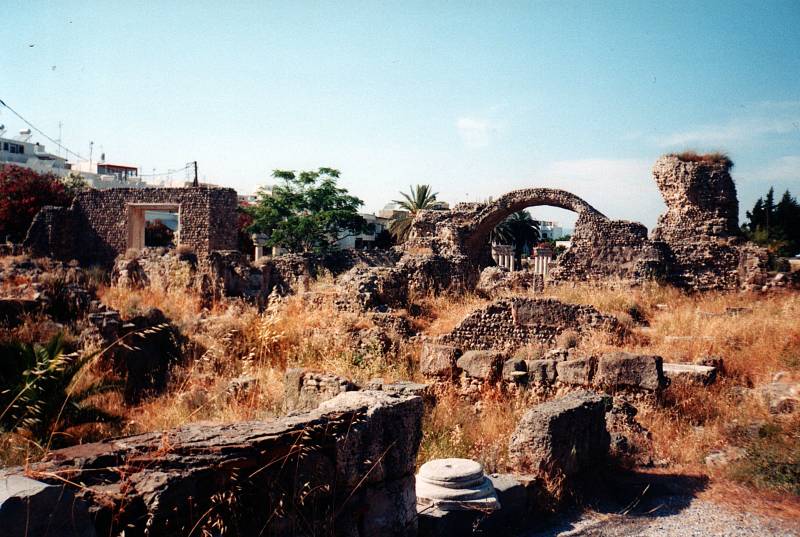
The agora was built in the 4th and 3rd centuries BCE.

It contained the Great Stoa and galleries with sanctuaries dedicated to Dionysius, Aphrodite, and Hercules.
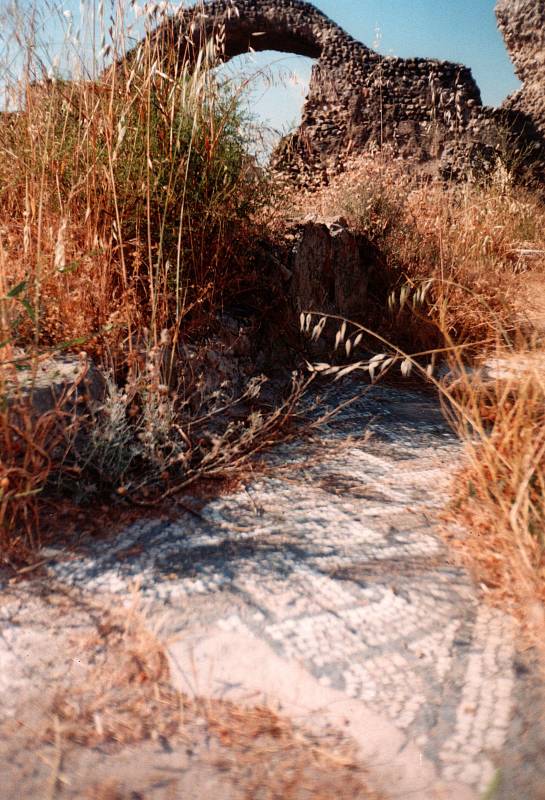
Sixteen columns remain from the Gymnasium out of the original seventy. The Hellenistic and Roman baths were here.

The Asclepeion of Kos
The Asclepeion or Ασκληπιείο is the most significant site on Kos. There were many Asclepeions, healing temples, in ancient Greece, and the subsequent Hellenistic and Roman cultures, but the one on Kos was the most significant one. By the time of the Byzantine destruction of non-Christian shrines it had been long abandoned, overgrown, and buried by blown-in soil.
These temples were dedicated to Asclepius, the first doctor-demigod in Greek mythology, said to have been so skilled that he could raise people from the dead. Homer described him in the Iliad as a man, a physician tending to soldiers injured at Troy. By the time of Hippocrates, 460-377 BCE, Asclepius had been elevated to godhood, the descendant of the god Apollo and the mortal Coronis.
Asclepius' father Apollo was a patron god of medicine. Apollo taught the art of medicine to Chiron, a wise and peaceful half-horse, half-human. And thus Chiron became the Centaur for Disease Control.
Asclepius carried a staff with a snake wrapped around it. That image survives today as a symbol of medicine.
Asclepeions contained carefully designed and controlled spaces conducive to healing. Treatment at the temple focused on promoting healthy lifestyles, with a special emphasis on the patient's spiritual needs.
This included incubation, a religious practice of sleeping in a sacred space in the hope of experiencing a divinely inspired dream that explained a cure. The Egyptians began practicing incubation under the influence of Imhotep in the late 27th century BCE. Imhotep was chancellor to the pharaoh Djoser, and high priest of Ra at Heliopolis. By the late 7th century BCE, Imhotep had been elevated to the status of a god, equated with Thoth, the god of architecture, mathematics, and medicine.
The Hebrews practiced incubation. Solomon, who ruled roughly 970-931 BCE, went to Gibeon for incubation. Gibeon was the most renowned high place of the time, where the people made sacrifices to gods.
The king [Solomon] went to Gibeon to offer sacrifices, for that was the most important high place, and Solomon offered a thousand burnt offerings on that altar. At Gibeon the Lord appeared to Solomon during the night in a dream, and God said, "Ask for whatever you want me to give you."
The Asclepeion is about 3.5 kilometers from the harbor. It's on higher ground with a view out to the water surrounding Kos, but it's not at the highest point on the island, Mount Dikaios or Όρος Δίκαιος at 846 m. The location of an Asclepeion was chosen to help the patient's emotional and psychological state. Location was everything with ancient Greek temples, as if the structures were intended to focus existing sacred space.
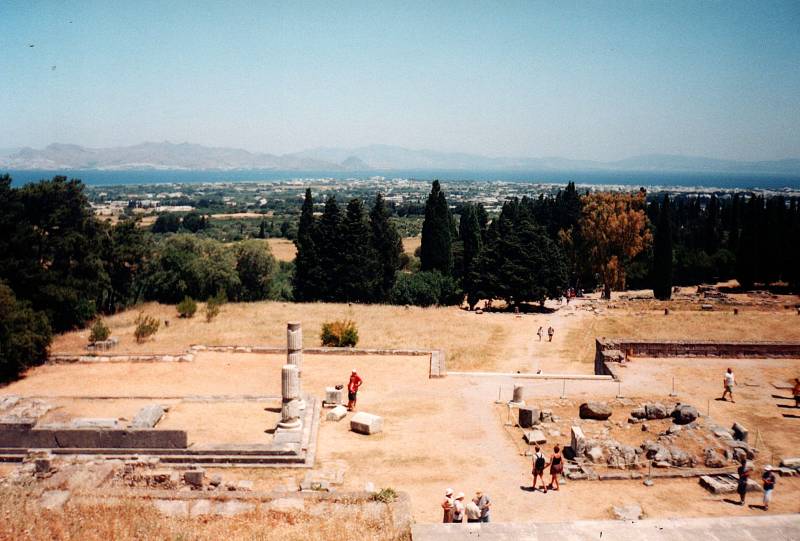
View from the Asclepeion to Kos town, and across the water beyond that, to Bodrum, Turkey.
At Kos one hoped that Asclepius himself or one of his healing children would visit the patient in a dream, relating what they needed to do to cure their ailment.
Admission into the Asclepeion was preceded by katharsis, or purification — several days of cleansing baths, purgatives, and a cleansing diet. Meditation and chanting could help transition the patient into a hypnotic state.
Delphi and AnesthesiaRecords of case histories describe opening abdominal abscesses, and post-trauma removal of foreign objects. These may have occurred with the patient in a dream-like state of induced sleep called έγκοίμησις or enkoimesis, a state similar to anesthesia, induced with the help of opium.
Hippocrates taught medicine at the Asclepeion on Kos. The medicine studied and practiced here was more scientific than that at other Asclepeions.
Hippocrates learned from Herodicus or Ήρόδικος, who is credited with the first use of therapeutic exercise for the treatment of disease and maintenance of health.
Hippocrates, the "Father of Medicine", is credited with being the first physician to believe that disease is the product of environmental factors and diet, and not punishment inflicted by the gods.
Hippocrates was, if anything, too successful and influential. His teachings were considered to be too great to be improved upon. Centuries later, in the Middle Ages, the Islamic world adopted Hippocratic methods and developed new medical technologies which eventually made their way to Europe.
The three-level architecture of the mid-300s BCE Asclepeion is an Asian architectural design imported after the conquests of Alexander the Great.
About a hundred years later, in 260 BCE during the reign of Ptolomy, all the Hellenic world recognized the right of legal protection in a sanctuary of Asclepius.

At the time of my visit, Greece still used its own Drachma. The 10,000 Δρ note showed Doctor Georgios Papanikolaou (1883-1962), who developed the Pap(anikolaou) Smear test, on the obverse; the Asclepeion of Kos was on the reverse.
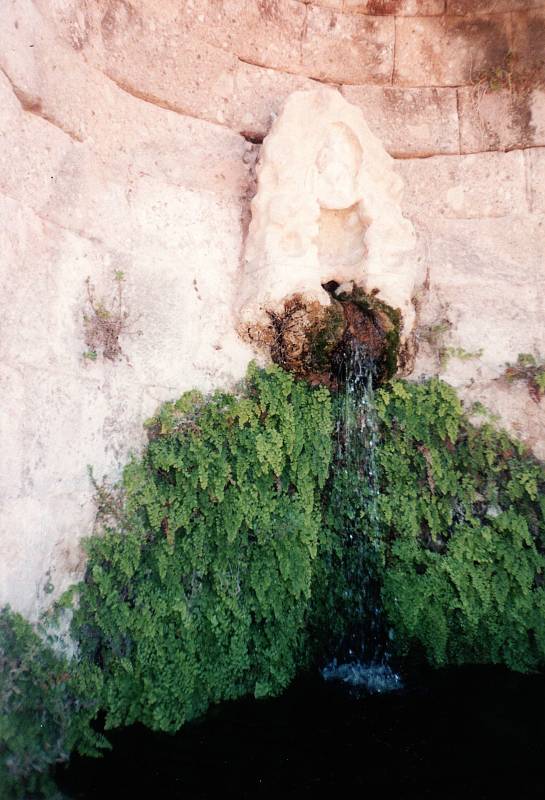

Back to the Harbor
I got a ferry ticket for Bodrum. I would see the Mausoleum, the Tomb of King Mausalus, one of the Seven Wonders of the Ancient World. Well, the site of it and some slight remains. The Knights Hospitaller had disassembled the Mausoleum to build the Castle of Saint Peter.
Tamerlane had invaded Anatolia in 1402, distracting the young Ottoman Empire. The knights captured Bodrum and then needed a defensive base. The castle defended Bodrum, although not always successfully, through the end of World War I.
VisitingTurkey
After Bodrum, I would travel more in Turkey.
Greece and Turkey each view the other as the Evil Empire. While Turkey is clearly visible across the water, it's a land of mystery and dread in Greece. Greek maps usually depict Turkey as a blank landmass. If it's labeled at all, it's as the anachronistic "Asia Minor".
The tension is made worse by the dispute over the Aegean sea. Most nations claim land, and then a standard territorial sea extending 12 nautical miles out from the low-water line. Both sides have claimed at times to control the water all the way to the other's shoreline.
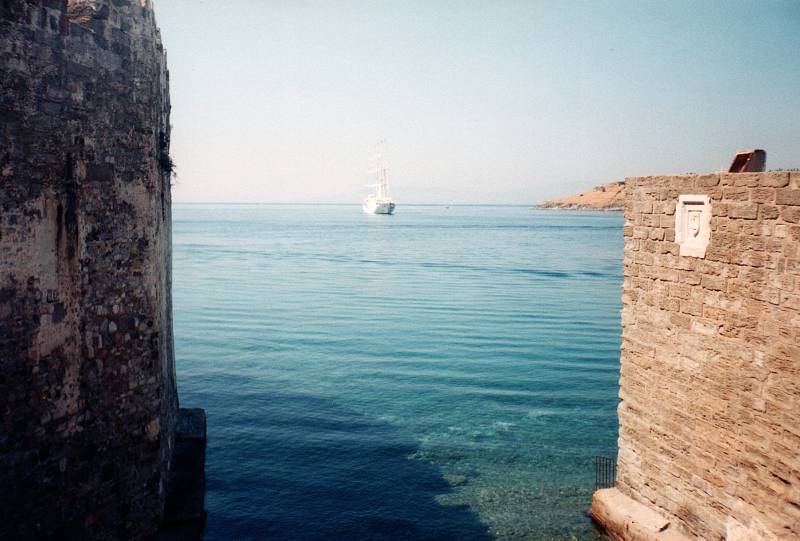
On the morning of the crossing, the preparation and paperwork takes about as long as the crossing itself. If you have a one-way ticket, instead of a day trip, you go to a special line where they copy all the details from your passport, writing by hand on a legal pad. Then there are special forms they must first find, and then fill out. It took longer to process the three of us going one-way than it took for the 150 people going just for the day and then returning.
Then, instead of going to the regular immigration booth, with the uniformed officer, you're sent to a different window. When I crossed, it was the one staffed by the girl in the black Harley-Davidson T-shirt.
Finally, you get a bright green laminated card to board the ferry, where the staff confiscates everyone's passports for the crossing.
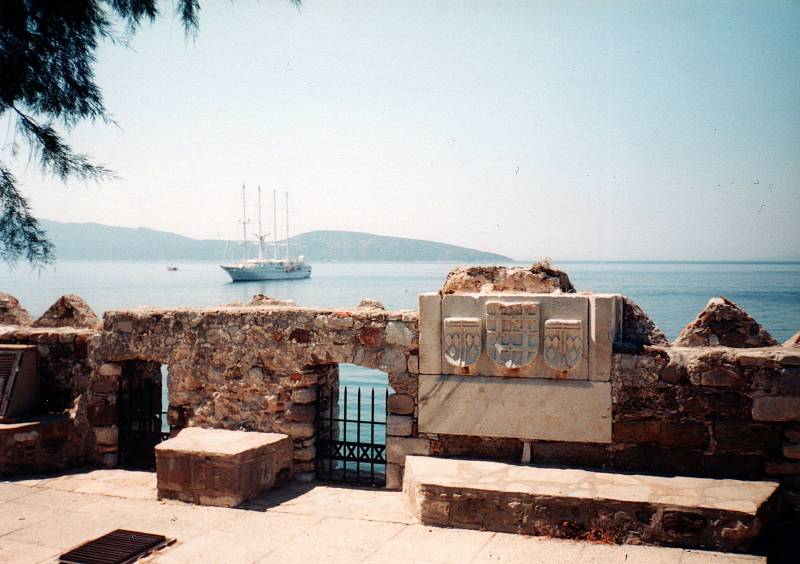
Where next?